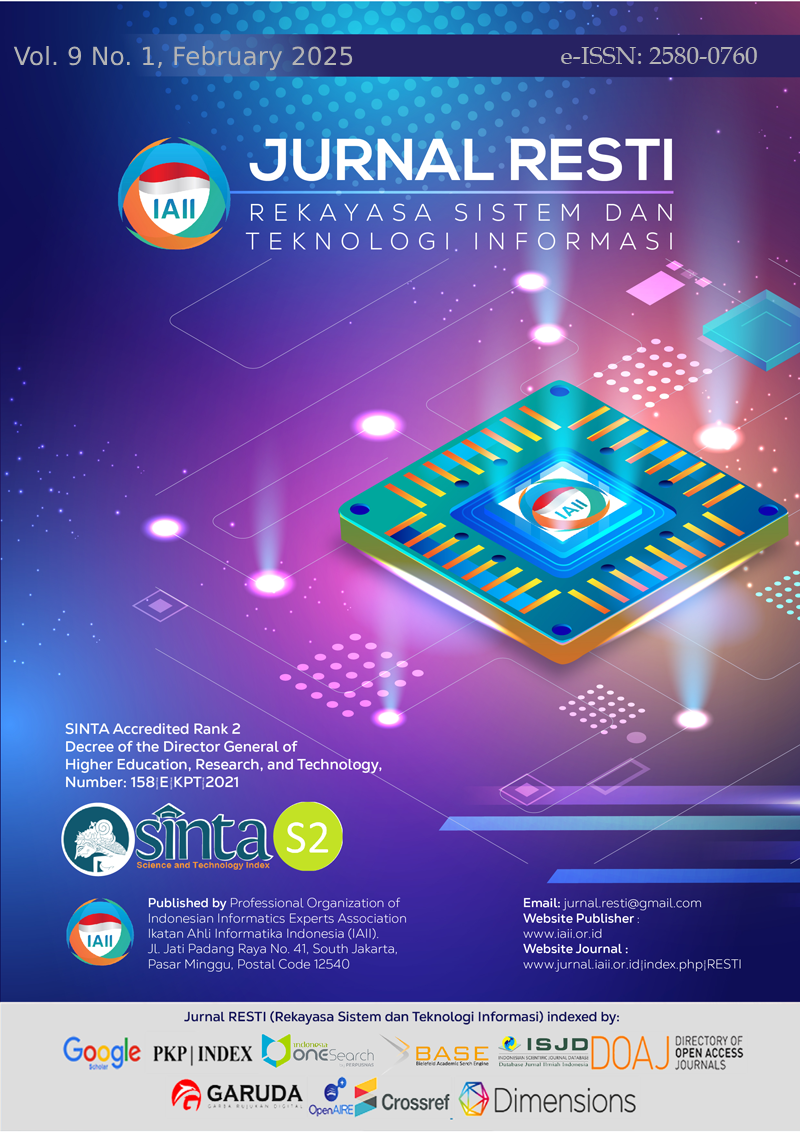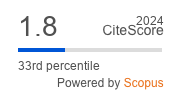Prediction of Main Transportation Modes using Passive Mobile Positioning Data (Passive MPD)
Abstract
Indicators of the main mode of transportation used by domestic tourists during tourism trips cannot yet be estimated using Passive MPD which is recorded based on the location of the BTS that captures the cellular activity of domestic tourists. Previous research on identifying transportation modes from Passive MPD has its own shortcomings because it only relies on speed and travel time features. Meanwhile, there is Active MPD which is recorded using active geo-positioning and real-time, where the research involves many features and has a data structure similar to Passive MPD. Therefore, this research aims to conduct a study of the implementation of the method used to identify modes of transportation in Active MPDs to Passive MPDs as an approach to predicting the main modes of transportation. As a result, the transportation mode identification method in the Active MPD can be implemented in the Passive MPD. The best accuracy of 83.56% was obtained by the LightGBM model using all features. However, the Multinomial Logistic Regression model, which only uses 10 selected features, is the most effective and efficient model with an accuracy of 76.43% and a much shorter execution time
Downloads
References
Badan Pusat Statistik, “Statistik Wisatawan Nusantara 2018,” Jakarta, 2019.
Badan Pusat Statistik, “Statistik Wisatawan Nusantara 2019,” Jakarta, 2020.
Badan Pusat Statistik, “Statistik Wisatawan Nusantara 2020,” Jakarta, 2021.
Badan Pusat Statistik, “Statistik Wisatawan Nusantara 2021,” Jakarta, 2022.
Badan Pusat Statistik, “Statistik Wisatawan Nusantara 2022,” Jakarta, 2023.
R. Ahas, A. Aasa, S. Silm, and M. Tiru, Mobile Positioning Data in Tourism Studies and Monitoring: Case Study in Tartu, Estonia. 2007. doi: 10.1007/978-3-211-69566-1_12.
A. Kuusik, M. Tiru, R. Ahas, and U. Varblane, “Innovation in destination marketing: The use of passive mobile positioning for the segmentation of repeat visitors in Estonia,” Balt. J. Manag., vol. 6, pp. 378–399, Sep. 2011, doi: 10.1108/17465261111168000.
Y. Zheng, Y. Chen, Q. Li, X. Xie, and W.-Y. Ma, “Understanding Transportation Modes Based on GPS Data for Web Applications,” TWEB, vol. 4, Jan. 2010, doi: 10.1145/1658373.1658374.
Q. Zhu et al., Identifying Transportation Modes from Raw GPS Data:, vol. 623. 2016. doi: 10.1007/978-981-10-2053-7_35.
J. Li, X. Pei, X. Wang, D. Yao, Y. Zhang, and Y. Yue, “Transportation mode identification with GPS trajectory data and GIS information,” Tsinghua Sci. Technol., vol. 26, pp. 403–416, Aug. 2021, doi: 10.26599/TST.2020.9010014.
A. Witayangkurn, T. Horanont, N. Ono, Y. Sekimoto, and R. Shibasaki, Trip Reconstruction and Transportation Mode Extraction on Low Data Rate GPS Data from Mobile Phone. 2013.
R. Ahas, S. Silm, O. Järv, E. Saluveer, and M. Tiru, “Using Mobile Positioning Data to Model Locations Meaningful to Users of Mobile Phones,” J. Urban Technol., vol. 17, pp. 3–27, Apr. 2010, doi: 10.1080/10630731003597306.
R. Ahas, S. Silm, E. Saluveer, and O. Järv, “Modelling Home and Work Locations of Populations Using Passive Mobile Positioning Data,” in Location based services and telecartography II: From sensor fusion to context models, 2009, pp. 301–315. doi: 10.1007/978-3-540-87393-8_18.
Kyaing, K. K. Lwin, and Y. Sekimoto, “Identification of various transport modes and rail transit behaviors from mobile CDR data: A case of Yangon City,” Asian Transp. Stud., vol. 6, p. 100025, 2020, doi: https://doi.org/10.1016/j.eastsj.2020.100025.
H. Wang, F. Calabrese, G. Di Lorenzo, and C. Ratti, “Transportation mode inference from anonymized and aggregated mobile phone call detail records,” in 13th International IEEE Conference on Intelligent Transportation Systems, 2010, pp. 318–323. doi: 10.1109/ITSC.2010.5625188.
A. P. Putra, W. O. Z. Madjida, I. A. Setyadi, A. R. S. Nugroho, and A. R. M. Munaf, “AMDA: Anchor Mobility Data Analytic for Determining Home-Work Location from Mobile Positioning Data ,” Proc. Int. Conf. Data Sci. Off. Stat., vol. 2021, no. 1 SE-Data Science, pp. 296–304, Jan. 2022, doi: 10.34123/icdsos.v2021i1.239.
S. Rokhmah and N. A. Rozaq Rais, “APPLICATION OF DATA MINING FOR PREDICTION OF LONG COVID ON COVID-19 SURVIVAL WITH FEATURE SELECTION AND NAÏVE BAYES METHOD,” J. Tek. Inform., vol. 3, no. 5 SE-Articles, pp. 1397–1405, Oct. 2022, doi: 10.20884/1.jutif.2022.3.5.561.
C. J. S. Leo Breiman, Jerome Friedman, R.A. Olshen, Classification and Regression Trees, 1st ed. New York: Chapman and Hall/CRC, 1984. doi: https://doi.org/10.1201/9781315139470.
L. Breiman, “Random Forests,” Mach. Learn., vol. 45, no. 1, pp. 5–32, 2001, doi: 10.1023/A:1010933404324.
R. E. Schapire, “A brief introduction to boosting,” in Proceedings of the 16th International Joint Conference on Artificial Intelligence - Volume 2, in IJCAI’99. San Francisco, CA, USA: Morgan Kaufmann Publishers Inc., 1999, pp. 1401–1406.
T. Chen and C. Guestrin, XGBoost: A Scalable Tree Boosting System. 2016. doi: 10.1145/2939672.2939785.
G. Ke et al., “LightGBM: A Highly Efficient Gradient Boosting Decision Tree,” in Advances in Neural Information Processing Systems, I. Guyon, U. Von Luxburg, S. Bengio, H. Wallach, R. Fergus, S. Vishwanathan, and R. Garnett, Eds., Curran Associates, Inc., 2017. [Online]. Available: https://proceedings.neurips.cc/paper_files/paper/2017/file/6449f44a102fde848669bdd9eb6b76fa-Paper.pdf
J. Starkweather and A. K. Moske, “Multinomial Logistic Regression,” Texas, 2011.
R. Mubarak, M. Hanafi, and D. Sasongko, “Komparasi Performa Naive Bayes Gaussian dan K-NN Untuk Prediksi Kelulusan Mahasiswa dengan CRISP-DM,” KLIK Kaji. Ilm. Inform. dan Komput., vol. 4, no. 6, p. 2982 2991, 2024.
I. Mekongga, R. Gernowo, and A. Sugiharto, “The Prediction of Bandwidth On Need Computer Network Through Artificial Neural Network Method of Backpropagation,” J. Sist. Inf. Bisnis; Vol 2, No 2 Vol. 2 Nomor 2 Tahun 2012DO - 10.21456/vol2iss2pp098-107, Jun. 2012, [Online]. Available: https://ejournal.undip.ac.id/index.php/jsinbis/article/view/40
V. Y. P. Ardhana et al., “Prediksi Flight Delay Berbasis Algoritma Neural Network,” J. Informatics, Electr. Electron. Eng., vol. 2, no. 1, 2022.
S.Suganya and N.Kamalraj, “A SURVEY ON CREDIT CARD FRAUD DETECTION,” 2015. [Online]. Available: https://api.semanticscholar.org/CorpusID:212444345
“Thinkmetric. Speed.” [Online]. Available: https://thinkmetric.uk/basics/speed/
Copyright (c) 2025 Jurnal RESTI (Rekayasa Sistem dan Teknologi Informasi)

This work is licensed under a Creative Commons Attribution 4.0 International License.
Copyright in each article belongs to the author
- The author acknowledges that the RESTI Journal (System Engineering and Information Technology) is the first publisher to publish with a license Creative Commons Attribution 4.0 International License.
- Authors can enter writing separately, arrange the non-exclusive distribution of manuscripts that have been published in this journal into other versions (eg sent to the author's institutional repository, publication in a book, etc.), by acknowledging that the manuscript has been published for the first time in the RESTI (Rekayasa Sistem dan Teknologi Informasi) journal ;








